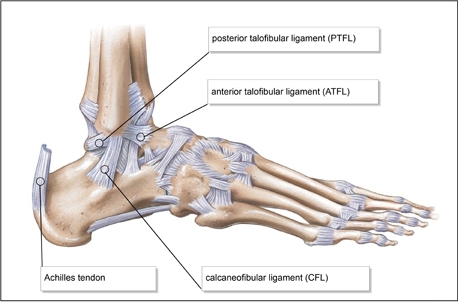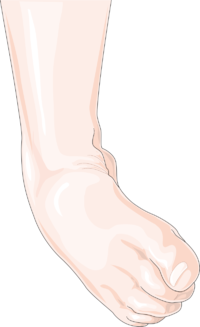Anterior Talo-Fibular Ligament (ATFL)
Original Editor - User Name
Top Contributors - Beverly Klinger, Kim Jackson and Shaimaa Eldib
Description[edit | edit source]
The Anterior Talo-Fibular Ligament (ATFL) is one of three ligaments that make up to Lateral Collateral Ligament of the ankle. The ATFL is a short ligament that widens slightly from top to bottom.[1]
Attachments[edit | edit source]
The anterior talofibular ligament originates from the anterior edge of the lateral malleolus of the fibula and attaches to the neck of the talus, in front of the lateral malleolar facet.[1]
Function[edit | edit source]
The function of the ATFL is to resist inversion and plantar flexion of the ankle joint.[2] Injury to the ATFL usually occurs when the athlete's center of gravity is shifted over the lateral border of the weightbearing leg, causing the ankle to roll inward at a high velocity. The ATFL is the weakest of the lateral collateral ligaments and therefore the first to be injured.[2]
Mechanisms of injury may include landing awkwardly on an opponent's foot, catching the outer aspect of the foot on the ground terrain, or a slide tackle that contacts the inside of the opponent's weightbearing leg.[2]
Clinical relevance[edit | edit source]
Assessment[edit | edit source]
When a patient presents with a possible ATFL injury, a full physical evaluation should be performed:
- Observation: Observe for gross abnormalities, edema, ecchymosis, and perform a neurovascular assessment.[2]
- Palpation: Palpate for areas of tenderness over the ATFL as well as other lateral collateral ligaments. Check the dorsal pedal pulse, capillary refill, and sensation to light touch. Edema can be measured by using a tape measure to make a figure-8 measurement that encompasses the medial malleolus, lateral malleolus, navicular, and base of the fifth metatarsal.[2]
- Range of Motion: Bilateral goniometric measurements should be taken of active and passive ranges of motion.[2]
- Special Tests:
- Anterior Drawer Test: While stabilizing the tibia and fibula with one hand, use the other hand to hold the foot in 20° of plantar flexion while the talus is drawn forward in the ankle mortise. The Anterior drawer tests the integrity of the ATFL and the anterior joint capsule. A positive test result is when there is greater than 5 mm of anterior motion of the STJ as compared with the non-injured ankle. An audible clunk may also be present during test.[2] Due to increased pain and swelling acutely, the anterior drawer test has been found to have a markedly increased sensitivity when performed 4 to 5 days after injury.[2]
- Talar Tilt Test: This test is primarily performed to determine the integrity of the CFL, however can also give valuable information about the ATFL. The test is performed with the ankle held in neutral position while the talus is tilted into adduction and abduction. Repeat the test with the foot in plantar flexion to evaluate the integrity of the ATFL. A positive test result is 5° to 10° of increased inversion as compared with the non-injured ankle, indicating a CFL injury.[2]
Examination Findings:
- Swelling observed distal to the lateral malleolus of the ankle that may extend to the foot if the lateral capsule is torn.
- Tenderness palpated over the ATFL and, in more severe cases, the CFL.
- The anterior drawer and the talar tilt test may reveal joint laxity due to tearing of the ATFL and/or the CFL ligament.
- Stress radiographs may reveal excessive anterior translation of the talus or inversion of the talus.
Classification of Lateral Ankle Sprains:
- Grade 1: Small tear of the ATFL. Symptoms include minimal swelling and point tenderness directly over the ATFL, little to no instability, and the patient is able to ambulate with little to no pain.[2]
- Grade 2: Large tear of the ATFL. Symptoms include a broader region of point tenderness over the lateral aspect of the ankle, a painful gait or inability to ambulate, bruising and localized swelling due to tearing of the anterior joint capsule, ATFL, and surrounding soft tissue structures.[2]
- Grade 3: Complete rupture of the ATFL with possible involvement of the CFL. Symptoms include diffuse swelling that obliterates the margins of the Achilles tendon, inability to ambulate, and tenderness on the lateral and medial aspects of the ankle joint.[2]
Radiography
Ottawa guidelines should be used to determine if radiographs are required:
- Tenderness over the medial malleolus, lateral malleolus, navicular, and/or base of the fifth metatarsal upon palpation;
- An inability to weight bear immediately following injury or during the clinical evaluation;
- Tenderness that extends 6 cm superiorly from either malleolus
If gross abnormalities are present, radiographs should be performed immediately. Standard radiographic views include anterior to posterior, lateral, and ankle mortise.
Treatment[edit | edit source]
Resources[edit | edit source]
References[edit | edit source]
- ↑ 1.0 1.1 Bonnel FT, Toullec E, Mabit C, Tourné Y. Chronic ankle instability: biomechanics and pathomechanics of ligaments injury and associated lesions. Orthopaedics & traumatology: Surgery & research. 2010 Jun 1;96(4):424-32.
- ↑ 2.00 2.01 2.02 2.03 2.04 2.05 2.06 2.07 2.08 2.09 2.10 2.11 Dubin JC, Comeau D, McClelland RI, Dubin RA, Ferrel E. Lateral and syndesmotic ankle sprain injuries: a narrative literature review. Journal of chiropractic medicine. 2011 Sep 1;10(3):204-19.
- ↑ Clinically Relevant Technologies. Available from: http://www.youtube.com/watch?v=Z4rvAT3a7OY. [Last Accessed: 21 October 2020
- ↑ The Physio Channel. How to do the Talar Tilt Test for the ankle. Available from: https://www.youtube.com/watch?v=dp7usAmLl5c [Last Accessed: 21 October 2020]








